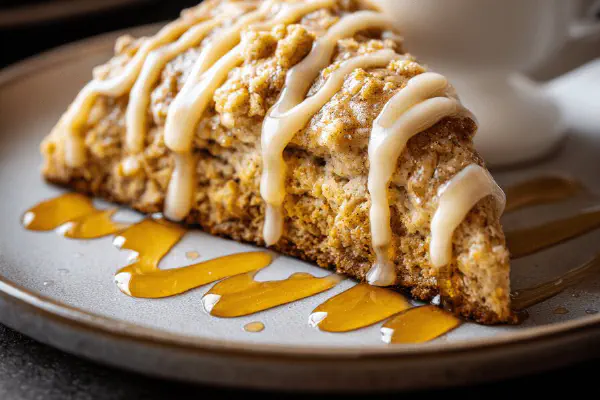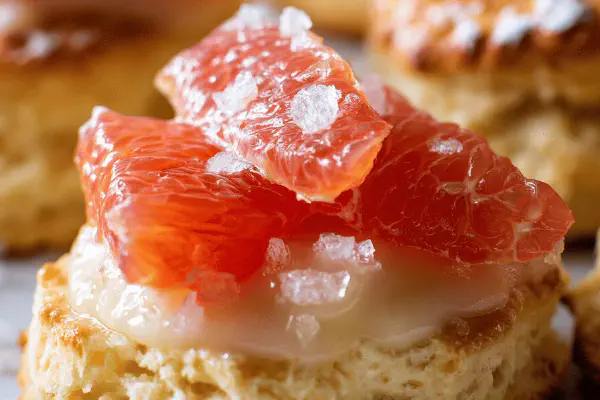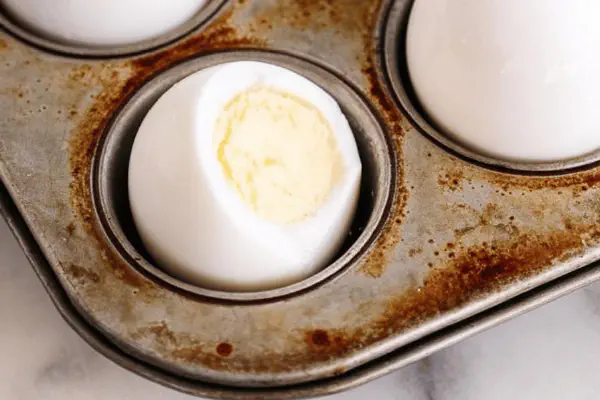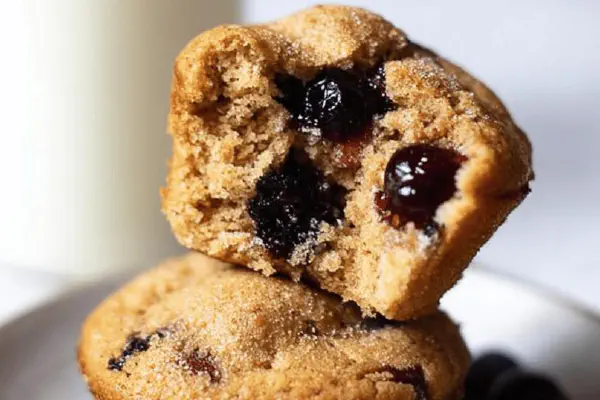Flaky Cinnamon Layered Scones

By Emma
Certified Culinary Professional
Ingredients
Scones
- 400 g bread flour (about 3 cups)
- 60 g light brown sugar (¼ cup packed)
- 10 ml baking powder (2 tsp)
- 5 ml fine sea salt (1 tsp)
- 2 ml baking soda (½ tsp)
- 160 g cold unsalted butter diced small
- 170 ml honey
- 5 ml ground cinnamon (1 tsp)
- 2 ml ground ginger (½ tsp)
Glaze
- 20 ml melted unsalted butter (1 tbsp)
- 25 ml dark brown sugar (1 tbsp packed)
About the ingredients
Method
Prep
- Mix dry: flour, sugar, baking powder, salt, soda — well combined to distribute rising agents evenly. Tiny lumps of butter tossed in, work quickly with pastry cutter or pulses in food processor — pea-sized is goal, not uniform crumbs.
- Honey warmed to just lukewarm (not hot or butter melts too soon) added, fold lightly with spatula. Dough feels shaggy but sticks a little. Save overmixing, stop once flour disappears but dough still rough.
- Turn onto floured surface. Press and fold dough onto itself several times — folding keeps layers, adds flakiness later. Shape into 22x22 cm (9 inch) square. This step can be knee work or fast hands; never knead like bread but enough to hold shape.
- Sprinkle cinnamon and ginger evenly atop dough surface. Don’t massage it in — keep spices layered for bursts.
Layering
- Cut dough square into 4 quadrants. Stack carefully one on another. Press lightly to unify stacks but keep them distinct layers visible at edges. Press back into same 22x22 cm square.
- Transfer dough to lined baking tray. Wrap in plastic, chill freezer 20 minutes til firm but not frozen solid. This rest firms butter making it stay cold in oven, key for flaky layers.
Shaping & Finishing
- Remove dough, trim uneven edges for neat rectangle. Brush top with melted butter thickly to help sugar stick and promote browning.
- Sprinkle dark brown sugar evenly; press gently into dough surface with fingers to secure.
- Slice into 9 equal squares; arrange spaced apart on lined tray. Chill 10 minutes if you want to bake later or freeze for up to 1 month.
Baking & Indicators
- Oven rack center, preheat at 205°C (400°F). Hot air and convection fan if available necessary for strong oven spring and color.
- Bake 15–17 minutes; rotate tray halfway. Look for deep golden edges, crisp cracks on sugar crust, and puffed layers separating slightly at seams.
- Touch top lightly — should resist indentation, edges lightly firm but not hard. Internal crumb moist but set.
- Cool 10 minutes on rack. Serve warm or room temp.
Tips & Troubleshooting
- Too soft dough? Add flour slowly to stiffen. If butter melts, fridge 10 more min before baking.
- Honey can replace buttermilk but expect milder acidity and softer crumb. Adjust sugar to taste.
- For no honey, use cold yogurt or kefir for similar acid content.
- If scones spread too much, dough too warm or butter too soft. Chill longer next time.
- Use bread flour here for better gluten structure — more chew and lift than AP flour.
- Spices can swap or combine with cardamom, nutmeg for seasonal twist.
- Glaze sugar caramelizes with butter, gives crunch and contrast to flaky softness.
- Watch oven closely last 5 minutes! Sugar topping can burn fast.
- Leftovers reheat well in low oven or toaster oven to restore crisp edges.
- Freeze portions baked or unbaked — no compromise on texture.
Cooking tips
Chef's notes
- 💡 Butter must be cold, diced small lumps not crumbs. Warm kitchen melts fat fast. Use pastry cutter or quick pulses in food processor. Visual check: pea-sized clumps visible in dough. This traps steam, lifts layers. Overworking starts gluten too soon, tough scones ahead. Fold dough gently but with purpose—layers create flaky texture, no rushing.
- 💡 Honey replaces buttermilk but keep temp lukewarm never hot. Hot liquid melts butter early, ruins layering. If no honey, try thick yogurt or kefir—same acid effect but different moisture. Brown sugar glaze needs thick melted butter; brush thickly for deep caramel crust. Press sugar into surface lightly to hold during baking without sinking.
- 💡 Chill dough after folding at least 20 minutes; butter solidifies again. Freezing works well if baking later; slice scones frozen or thaw slightly fridge. Watch oven toward end, sugar coating burns fast. Rotate tray halfway to twee hot spots. Oven rack middle height best for even heat and color. Don’t rely only on timer—look for deep gold edges and crackly sugar crust appearance.
- 💡 Dough texture expected shaggy with some dry flour still visible; don’t overmix. Press and fold on floured board creates visible layers, lets butter pockets stay intact. Square shape easy to handle but trim edges for neat rectangle; uneven bakes oddly. Don’t knead like bread—too much gluten develops, loses crumbliness. Rest dough well before shaping for best lift.
- 💡 Spices layered on top before folding keeps bursts, don’t stir in. Cinnamon and ginger combo adds warmth without overpowering. Swap for cardamom or nutmeg if wanted seasonal twist. I found layering spices tops surface works better to avoid muddy flavors. Brown sugar darkest type best for caramel notes but don’t overdo or it burns quickly.
Common questions
Why use bread flour instead of all-purpose?
Bread flour tougher gluten, chewier crumb. Gives structure holding layers. AP flour softer but might collapse flaky lift. For softer crumb, half mix works. Bread flour demands folding and chilling more, patience key.
How do I know when scones are done?
Check golden edges, crackly sugar crust with little cracks. Touch top gently, should resist but not hard. Internal crumb moist but set, no doughy feel. Oven times vary, look and feel not timer only. Color changes signal caramelization and bubbling butter steam done.
What if dough feels too soft?
Add flour slowly to stiffen no sweat. Butter melting early kills layers, chill longer if so. Dough sticky but workable okay if careful. Overmixing toughens dough more than softness. Rest again if needed, cold crucial. Use tactile cues not just recipe words.
Can I freeze scones or dough?
Freeze dough mid-shaping wrapped tightly, thaw in fridge before baking. Sliced frozen scones bake straight from freezer, add a few minutes. Baked scones freeze great, reheat low and slow to keep crunch. No texture loss if handled chilled properly. Keep glaze simple, sugar burns fast if frozen then thawed.



